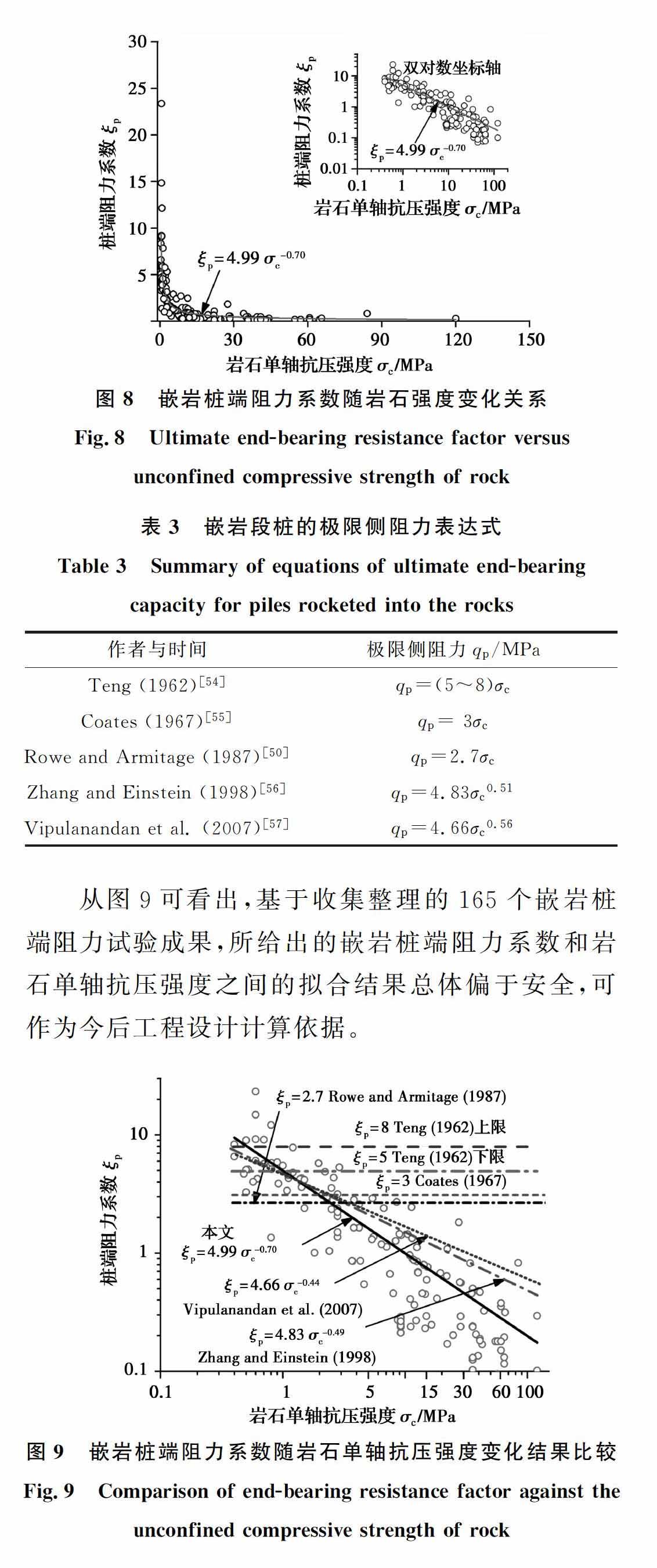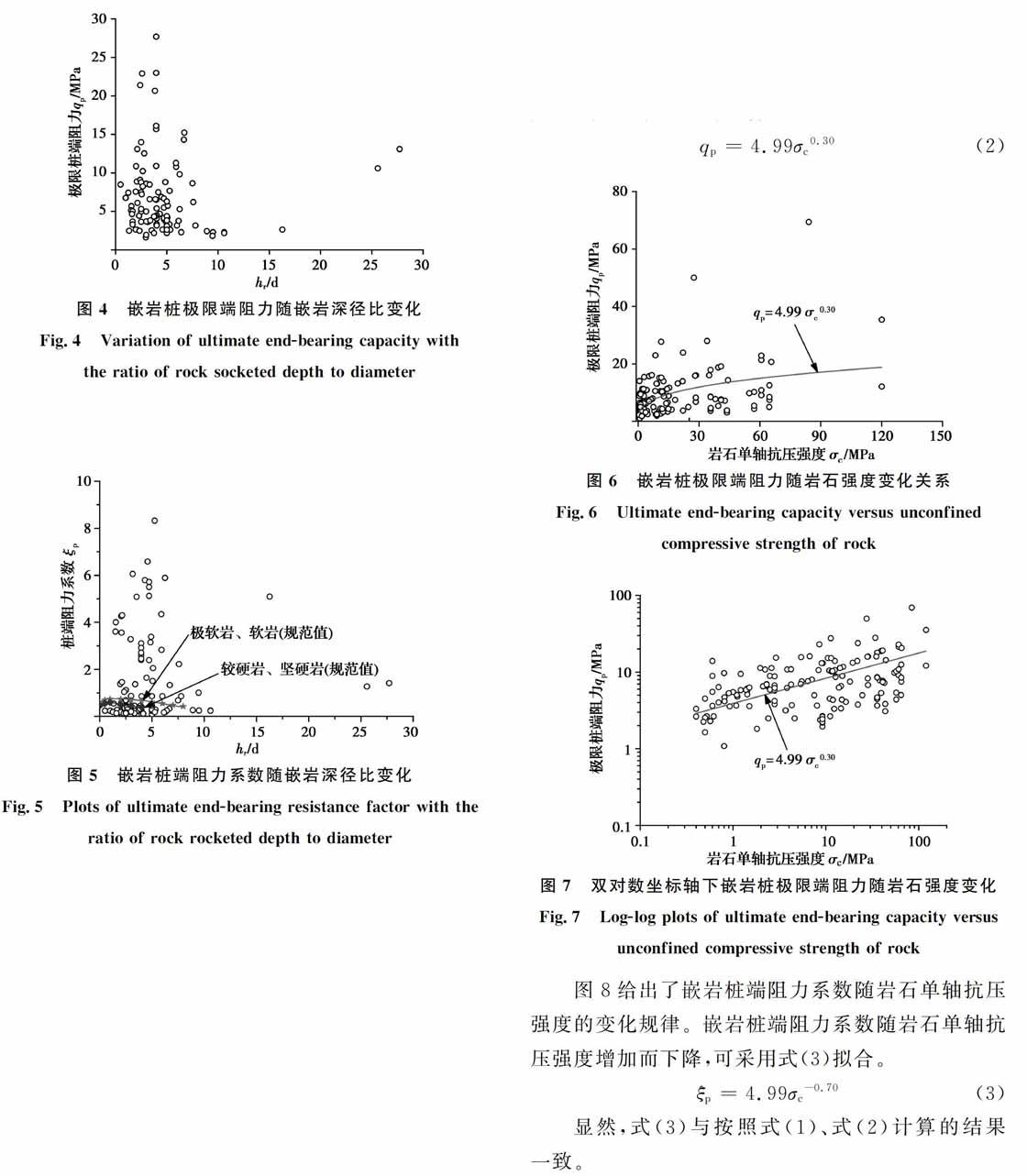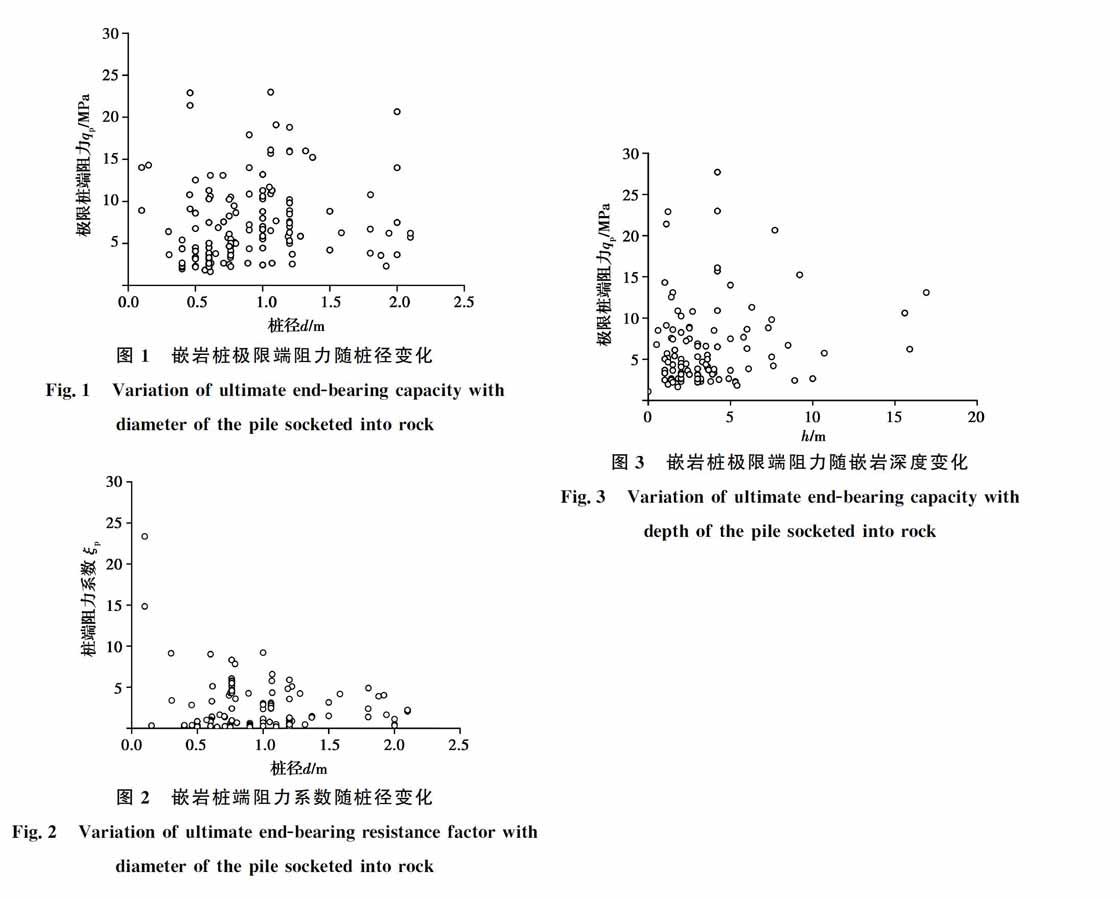嵌岩桩的极限端阻力发挥特性及其端阻力系数
鲁先龙 乾增珍 杨文智 郑卫锋



摘 要:嵌岩桩极限端阻力发挥特征及端阻力系数取值仍是岩土工程中嵌岩桩应用的重要研究课题之一。本文收集整理了国外不同地区学者在不同时期、不同岩石性质和不同嵌岩条件下所开展的165个嵌岩桩端阻力试验成果,主要包括嵌岩段岩石类型及其天然单轴抗压强度、嵌岩直径与嵌岩深度、嵌岩桩极限端阻力等。定义嵌岩桩极限端阻力与岩石天然单轴抗压强度的比值为嵌岩桩端阻力系数,分析了桩径、嵌岩深度、嵌岩深径比和岩石强度对嵌岩桩极限端阻力和端阻力系数的影响规律,建立了嵌岩桩极限端阻力及端阻力系数与岩石单轴抗压强度之间的拟合关系式,可为嵌岩桩极限端阻力计算提供借鉴。
关键词:嵌岩桩;端阻系数;嵌岩深径比;岩石单轴抗压强度
中图分类号:TU411 文献标识码:A 文章编号:
Abstract: It is an important issue to investigate the characteristics of end-bearing capacity and to determine the end-bearing resistance factor for the application of rock-socketed piles. In this study, the results of 165 compression load tests were collected to examine several issues related to the end-bearing capacity behavior of rock-socket piles. All these load test results were conducted on different rocks with different rock-socket piled conditions by different authors worldwide. Using these load test data, the type and the uniaxial compressive strength of rock in nature, the diameter and the embedment depth of socketed piles, the ultimate end-bearing resistances were compiled. The ratio of ultimate end-bearing capacity to unconfined compressive strength of the rock was defined as the end-bearing resistance factor of rock-socketed piles. Effects of the pile diameter, the pile depth rocked into rock, the ratio of rocketed depth to diameter, and the unconfined compressive strength of the rock on the ultimate end-bearing capacity and the end-bearing resistance factor were comprehensively investigated. An empirical relation between the unconfined compressive strength and the end-bearing capacity as well as the end-bearing resistance factor were suggested, which could be used in the design for rock-socketed piles.
Key words: rock-socket pile; end-bearing resistance factor; ratio of pile rocketed depth to diameter; unconfined compressive strength of rock
嵌巖桩作为承受大型建(构)筑物荷载的主要基础型式,已在工程中得到了广泛应用。然而,由于嵌岩桩具有承载力大、试验费用高且难以进行破坏性试验等特点,系统且完整的静载试验实测数据不多,从而制约了人们对嵌岩桩承载性状的全面认识[1-2]。目前,各行业规范对嵌岩桩承载力计算主要是经验和半经验公式,经验参数较多[3],设计方法及其参数取值也不尽相同,其原因主要源于对嵌岩桩荷载传递机理与承载性状认识存在偏差[4]。
我国建筑地基基础设计规范[5]认为嵌岩桩是端承桩,按端承桩设计。但国内外学术界和工程界都普遍认为,嵌岩桩抗压承载力主要由基岩上覆土层桩侧阻力、嵌岩段桩侧阻力和桩端阻力3部分组成,这已体现在我国相关规范[6-9]所给出的嵌岩桩承载力设计方法中。文献[10]通过收集整理嵌岩桩竖向下压承载力试验成果,分析了桩径、嵌岩深度、嵌岩深径比和岩石强度对嵌岩桩嵌岩段桩侧极限阻力和岩石极限侧阻力系数的影响规律,建立了嵌岩段岩石极限侧阻力系数与岩石单轴抗压强度之间的拟合关系式,给出了不同可靠度水平下岩石侧极限阻力系数取值建议。但大量现场试验表明[11-14],嵌岩桩在竖向荷载作用下,首先桩体发生竖向位移,桩体和桩侧岩土体之间发生相对位移,桩顶荷载通过桩侧岩土体阻力逐渐传递至桩端,嵌岩段桩侧阻力一般先于桩端阻力发挥。嵌岩桩岩石端阻力发挥过程更加复杂,研究嵌岩桩极限端阻力发挥特征将具有重要的理论和实践意义。
本文收集整理了国外学者在不同时期、不同地区、不同岩石强度和不同嵌岩条件下所完成的165个嵌岩桩竖向下压承载力试验成果,分析了桩径、嵌岩深度、嵌岩深径比和岩石强度对嵌岩桩极限端阻力和端阻力系数的影响规律,建立了嵌岩桩极限端阻力及端阻力系数与岩石天然单轴抗压强度之间的拟合关系式,可为嵌岩桩极限端阻力计算提供借鉴。
1 试验数据收集与整理
1.1 数据收集
这里需特别说明,本文所引用文献的试验工作是不同时期、不同地区学者,分别在不同岩石类型与强度、不同桩端嵌岩条件下完成的,作者对嵌岩桩极限端阻力的测试方法、极限承载力确定原则等方面也不尽相同。本文分析中均直接采用了原文献结果,这种方法分析得到的研究结论将更具一般性。
1.2 数据整理与分析
如表2所示,嵌岩桩抗压承载性能差异主要由嵌岩段岩体性质和桩端嵌岩特征不同引起。桩端嵌岩特征主要包括桩径、嵌岩深度、嵌岩深径比。表2中嵌岩段岩石主要包括黏土岩、页岩、泥页岩、砂砾岩、石膏岩、石灰石、凝灰岩和角砾岩等多种类型。
我国规范[49]指出,影响岩体性质的因素主要是岩石物理力学性质、构造发育情况、荷载(工程荷载和初始应力)、应力应变状态、几何边界条件、水的赋存状态等。在这些因素中,岩石坚硬程度则是反映了岩体基本特性的一个重要因素。这里还需要特別说明的是,规范[49]中岩石坚硬程度是按岩石饱和单轴抗压强度大小进行划分,而本文所引用文献中的岩石强度σc均为岩石天然单轴抗压强度,这是二者的不同。
2 岩石极限端阻力与端阻力系数影响因素
根据表2所收集与整理的嵌岩桩端阻力试验数据,分析桩径、嵌岩深度、嵌岩深径比和岩石强度对嵌岩桩极限端阻力和端阻力系数的影响规律。
2.1 桩径
图1和图2分别为嵌岩桩极限端阻力及端阻力系数随桩径变化的规律。图1和图2结果表明,桩径对嵌岩极限桩端阻力影响并不显著,嵌岩桩极限端阻力与桩径之间无明显相关性。桩端阻力系数总体随桩径增加而呈下降趋势,当桩径小于0.5m时尤为明显,当桩径大于0.5m后,这种下降趋势表现得并不显著。
2.2 嵌岩深度
嵌岩深度不仅影响嵌岩段侧阻力发挥性状,对桩端分担的荷载大小也有较大影响。此外,嵌岩深度也直接关系到嵌岩桩应用的安全性和经济性。嵌岩深度大,虽安全可靠,但施工难度大、费用高。反之,嵌岩深度过小,若桩端岩性差,嵌岩桩承载力和沉降可能不满足上部结构要求。图3给出了嵌岩桩极限端阻力随嵌岩深度变化规律。
图3表明,嵌岩桩极限端阻力随嵌岩深度变化虽有一定离散性,但总体上随嵌岩深度增加而略有减小,这与Rowe和Armitage[53]研究结论一致。即在一定嵌岩深度范围内,增加嵌岩深度可提高嵌岩桩承载力,但超过一定深度后,嵌岩深度的增加对单桩承载力几乎没有影响,即嵌岩桩存在最佳嵌岩深度,这也与我国学者对嵌岩深度普遍看法一致,嵌岩桩存在最佳嵌岩深度,可使嵌岩段桩侧阻力和桩端阻力发挥最为协调和充分。但不同学者对最佳嵌岩深度取值研究结论也是不一致的。黄求顺[12]认为最佳嵌岩深度为3d,而刘兴远等[54]认为一律将嵌岩深度取为3d不合理,应根据桩端所嵌入岩体状态确定。明可前[55]通过试验认为最佳嵌岩深度为4d。许锡宾等[56]认为硬质岩和软质岩最佳嵌岩深度分别取3d和5d较合理。
2.3 嵌岩深径比
图4为嵌岩桩极限端阻力随嵌岩深径比hr/d的变化规律。结果表明,嵌岩桩极限端阻力总体随嵌岩深径比的增大而减小,这与史佩栋等[13]统计分析结果一致。史佩栋等[13]根据国内外150根嵌岩桩下压实测结果,绘制了嵌岩桩极限端阻分担荷载比与桩身嵌岩深径比hr/d之间的关系曲线。结果表明,嵌岩桩极限端阻力总体随嵌岩深径比的增大而减小,当1.0
我国桩基规范[6]中嵌岩段侧阻和端阻综合系数是随嵌岩深度变化而变化的,在较小嵌岩深径比下,嵌岩段总阻力的发挥程度随嵌岩深度的增加而增大,而随着嵌岩深度继续增加,嵌岩段总阻力发挥程度有所变缓,嵌岩桩极限端阻力系数存在深度效应。图8给出了嵌岩桩极限端阻力系数随嵌岩深径比变化规律,也给出了规范[6]中2类岩石强度条件下,嵌岩桩极限端阻力系数随嵌岩深径比变化曲线。
从图5可看出,对极软岩和软岩(岩石饱和单轴抗压强度≤15MPa)、较硬岩和硬岩(岩石饱和单轴抗压强度>30MPa),我国规范取值总体偏小。同时,图5中端阻力系数与嵌岩深径比之间并无明显的相关性。而我国规范[6]中嵌岩桩端阻力系数取值与嵌岩深径比相关,随嵌岩深径比增加而略有下将,这与收集整理的试验结果并不吻合。
2.4 岩石强度
[4] 邢皓枫, 孟明辉, 罗勇, 等. 软岩嵌岩桩荷载传递机理及其破坏特征[J]. 岩土工程学报, 2011, 33(S2): 355-361.XING H F, MENG M H, LUO Y, et al. Load transfer mechanism and failure characteristics of piles embedded in soft rock[J]. Chinese Journal of Geotechnical Engineering, 2011, 33(S2): 355-361.(in Chinese)[维普]
[5] 建筑地基基础设计规范: GB50007—2011 [S]. 北京:中国建筑工业出版社,2011. Code for design of building foundation: GB50007—2011 [S]. Beijing: China Architecture and Building Press, 2011. (in Chinese)
[6] 建筑樁基技术规范: JGJ 94—2008 [S]. 北京:中国建筑工业出版社,2008. Technical code for building pile foundations: JGJ 94-2008 [S]. Beijing: China Architecture and Building Press, 2008. (in Chinese)
[7] 铁路桥涵地基和基础设计规范:TB 10002.5—2005 [S]. 北京:中国铁道出版社,2005. Code for design on subsoil and foundation of railway bridge and culvert: TB 10002.5-2005 [S]. Beijing: China Railway Publishing House, 2005. (in Chinese)
[8] 公路桥涵地基与基础设计规范:JTG D63—2007 [S]. 北京:人民交通出版社,2007. Code for design of ground base and foundation of highway bridges and culverts: JTG D63-2007 [S]. Beijing: China Communications Press, 2007. (in Chinese)
[9] 港口工程桩基规范:JTS 167—4—2012 [S]. 北京:人民交通出版社,2012. Code for pile foundation of harbor engineering: JTS 167-4-2012 [S]. Beijing: China Communications Press, 2012. (in Chinese)
[10] 鲁先龙, 乾增珍, 杨文智, 等. 嵌岩桩嵌岩段的岩石极限侧阻力系数[J]. 土木建筑与环境工程, 2018, 40(6): 29-38.LU X L, QIAN Z Z, YANG W Z, et al. Analysis on ultimate side shear resistance factor of piles socketed into rocks[J]. Journal of Civil,Architectural & Environmental Engineering, 2018, 40(6): 29-38.(in Chinese)
[11] 刘金砺.桩基础设计与计算.北京:中国建筑工业出版社,1990.85–95. LIU J L. Design and calculation of pile foundations [M]. Beijing: China Architecture and Building Press, 1990. (in Chinese)
[12] 黄求顺.嵌岩桩承载力的试验研究[C]//中国建筑学会地基基础学术委员会论文集.太原:山西高校联合出版杜,1992: 47–52. HUANG Q S. Load tests on bearing capacity of rock socketed piles. [C]//Proceedings of the Chinese Academy of Architecture Foundation. Taiyuan: Shanxi United University Press. 1992: 47–52.(in Chinese)
[13] 史佩栋,梁晋渝.嵌岩桩竖向承载力的研究 [J]. 岩土工程学报,1994,16(4):32–39. SHI P D, LIANF J Y. Vertical bearing capacity of rock-socketed piles [J]. Chinese Journal of Geotechnical Engineering, 1994, 16(4): 32–39. (in Chinese)
[14] 刘松玉,季鹏,韦杰.大直径泥质软岩嵌岩灌注桩的荷载传递性状[J]. 岩土工程学报,1998,20(4):58–61. LIU S Y, JI P,WEI J.. Load transfer behavior of large diameter cast-in-place pile embedded in soft rock [J]. Chinese Journal of Geotechnical Engineering, 1998, 20(4): 58–61. (in Chinese)
[15] REESE L C, HUDSON W R. Field testing of drilled shafts to develop design methods [R]. Research Report 89-1, Center for Highway Research, The University of Texas at Austin, 1968.
[16] VIJAYVERGIYA V N, HUDSON W R, REESE L C. Load distribution for a drilled shaft in clay shale [R]. Research Report 89-5, Center for Highway Research, The University of Texas at Austin, 1969.
[17] ENGELING D E, REESE L C. Behavior of three instrumented drilled shafts under short term axial loading [R]. Research Report 176-3, Center for Highway Research, The University of Texas at Austin, 1974.
[18] AURORA R P, REESE L C. Aurora, R. P., and Reese L. C. Behavior of axially loaded drilled shafts in clay-shales [R], Research Report 176-4, Center for Highway Research, The University of Texas at Austin, 1976.
[19] WEBB D L. The behaviour of bored piles in weathered diabase [J]. Geotechnique, 1976, 26(1): 63-72.
[20] WILSON L C. Tests of bored and driven piles in Cretaceous mudstone at Port Elizabeth, South Africa[J]. Géotechnique, 1976, 26(1): 5-12.[LinkOut]
[21] GOEKE P M, HUSTAD P A. Instrumented drilled shafts in clay-shale [C]// Proceedings of Symposium on Deep Foundations. Atlanta, GA. 1979: 149-164.
[22] THORNE C P. 1980. The capacity of piers drilled into rock [C]// Proceedings of the International Conference on Structural Foundations on Rock, Sydney, Australia, Vol. 1, 1980: 223–233.
[23] Williams, A. F. The design and performance of piles socketed into weak rock [D]. Ph. D. Thesis, Department of Civil Engineering, Monash University, Clayton, Vic., Australia, 1980.
[24] JUBENVILLE D M, HEPWORTH . Drilled pier foundations in shale [C]// Proceedings of Special National Conference Session A. Denver, Colorado Area, 1981.
[25] GLOS G H, BRIGGS O H J R. Rock sockets in soft rock [J]. Journal of Geotechnical Engineering, 1983, 109(4): 525–535.
[26] HORVATH R G, KENNEY T C, KOZICKI P. Methods of improving the performance of drilled piers in weak rock [R]. Canadian Geotechnical Journal, 1983, 20(4): 758-772.
[27] BAKER, C N J R. Comparison of caisson load tests on Chicago hardpan [C] // Proceedings of Session at the ASCE National Convention, ASCE, Reston, 1985, 99-113.
[28] SEIK, S, O'NEILL, M W, KAPASI K J. Behavior of 45° underream footing in eagle ford shale [R]. Research Report 85-12, University of Houston, December, 1985.
[29] HUMMERT J B, COOLING T L. Drilled pier test, Fort Collins, Colorado. [C]// Proceedings of the Second International Conference on Case Histories in Geotechnical Engineering, Vol. 3. Rolla, Missour: University of Missouri-Rolla. 1998, 1375-1382.
[30] ORPWOOD T G, SHAHEEN A A, KENNETH R P. Pressure-meter evaluation of glacial till bearing capacity in Toronto, Canada [M]. Kulhawy FH, editor. Foundation Engineering: current principles and practice, Vol. 1, Reston, VA, 1989, 16-28.
[31] RADHAKRISHNAN R, LEUNG C F. Load transfer behavior of rock-socketed piles[J]. Journal of Geotechnical Engineering, 1989, 115(6): 755-768.
[32] LEUNG C F, KO H Y. Centrifuge model study of piles socketed in soft rock.[J]. Soils and Foundations, 1993, 33(3): 80-91.[LinkOut]
[33] THOMPSON R W, III. Axial capacity of drilled shafts socketed into soft rock [D]. M.Sc. thesis, Auburn University, Auburn, Ala. 1994.
[34] CARRUBBA P. Skin of large-diameter piles socketed into rock [R]. Canadian Geotechnical Journal. 1997. 34(2): 230-240.
[35] O'NEILL M W. Applications of large-diameter bored piles in the United States [C] // Proceedings of the Third International Geotechnical Seminar on Deep Foundations on Bored and Auger Piles, Ghent, Belgium, 1998, 3-19.
[36] TCHEPAK S. The design and performance of bored pile in Shales for the Australia Stadium Project [C] // Proceedings of the Third International Geotechnical Seminar on Deep Foundations on Bored and Auger Piles, Ghent, Belgium, 1998, 341-348.
[37] OSTERBERG J. Load testing high capacity piles: What have we learned? [C] // Proceedings of the 5th International Conference on Deep Foundation Practice, Singapore, 2001.
[38] GUNNINK B, KIEHNE C. Capacity of drilled shafts in burlington limestone [J]. Journal of Geotechnical and Geoenvironmental Engineering, 2002, 128(1): 539-545.
[39] ABU-HEJLEH N M, O'NEILL M W, HANNEMAN D, et al. Improvement of the geotechnical axial design methodology for colorado's drilled shafts socketed in weak rocks[J]. Transportation Research Record: Journal of the Transportation Research Board, 2005, 1936(1): 100-107.
[40] BULLOCK, P J. A study of the setup behavior of drilled shafts [R]. Report submitted to the Florida Department of Transportation. University of Florida, Gainesville, Florida, 2003.
[41] MC VAY M, ELLIS K M, VILLEGAS J, KIM S H, LEE S M. Static and dynamic field testing of drilled shafts: Suggested guidelines on their use and for FDOT structures [R]. Report WPI No. BC354-08, FDOT, Department of Civil and Costal Engineering, University of Florida, 2003.
[42] MELLO L G, BILFINGER W, MENDES A S. A case study of rock socketed piles: design, control and construction of bored piles for a bridge foundation in Southeast Brazil [C] // Proceedings of the Fourth International Geotechnical Seminar on Deep Foundations on Bored and Auger Piles, Ghent, Belgium, 2003, 373-377.
[43] MILLER A D. Prediction of ultimate side shear for drilled shafts in Missouri shafts [D]. M.Sc. thesis, University of Missouri, Columbia, 2003.
[44] NAM M S. Improved design for drilled shafts in Rock [R]. Ph.D. thesis, University of Houston, Houston, Tex, 2004.
[45] ABU-HEJLEH N, ATTWOOLL W J. Colorados axial load tests on drilled shafts socketed in weak rocks: Synthesis and future needs [R]. Report CDOT-DTD-R-2005-4m Colorado Department of Transportation, Research Branch, Denver, Colo., 2005.
[46] BASARKAR S S, DEWAIKAR D M. Load transfer characteristics of rocketed piles in Mumbai region [J]. Soils and Foundations, 2006, 46(2): 247–257.
[47] GEO. Foundation design and construction. Geotechnical Control Office, Hong Kong. GEO publication No. 1/2006. 2006.
[48] KULKARNI R U, DEWAIKAR D M. Analysis of rock-socketed piles loaded in axial compression in Mumbai region based on load transfer characteristics[J]. International Journal of Geotechnical Engineering, 2019, 13(3): 261-269.
[49] 工程岩体分级标准:GB/T 50218—2014 [S]. 北京:中国计划出版社,2014. Standard for engineering classification of rock mass: GB 50021—2001 [S]. Beijing: China Planning Press, 2014. (in Chinese)
[50] ROWE R K, ARMITAGE H H. Theoretical solutions for axial deformation of drilled shifts in rock [J]. Canadian Geotechnical Journal, 1987, 24(1): 114–125.
[51] 刘兴远,郑颖人,林文修.关于嵌岩桩理论研究的几点认识[J]. 岩土工程学报,1998,20(5):118–119. LIU X Y, ZHENG Y R, LIN W X. Some understanding on the theories of rock socketed pile foundations[J]. Chinese Journal of Geotechnical Engineering, 1998, 20(5): 118–119. (in Chinese)
[52] 明可前.嵌岩桩受力机理分析[J].岩土力学,1998,19(1):65–69. MING K Q. Analysis of bearing mechanism of soeketed pile [J]. Rock and Soil Mechanics, 1998, 19(1): 65–69. (in Chinese)
[53] 许锡宾, 周亮, 刘涛, 等. 大直径嵌岩桩单桩承载性能的有限元分析[J]. 重庆交通大学学报(自然科学版), 2010, 29(6): 942-946,977.XU X B, ZHOU L, LIU T, et al. Finite element analysis of load-bearing properties of large diameter rock-socketed single pile[J]. Journal of Chongqing Jiaotong University(Natural Sciences), 2010, 29(6): 942-946,977.(in Chinese)[萬方]
[54] TENG W C. Foundation design [M], Prentice-Hall, Inc., Englewood Cliffs, N.J., 1962.
[55] COATES D F. Rock mechanics principles. Energy Mines and Resources, Ottawa, Ont. Monograph, 1967.
[56] ZHANG L Y, EINSTEIN H H. End bearing capacity of drilled shafts in rock[J]. Journal of Geotechnical and Geoenvironmental Engineering, 1998, 124(7): 574-584.
[57] VIPULANANDAN C., HUSSAIN A, USLUOGULARI O. Parametric study of open core-hole on the behavior of drilled shafts socketed in soft rock [C] // Contemporary Issues in Deep Foundations: Proceedings of Geo-Denver 2007, Denver, Colo., 18–21 February 2007. Geotechnical Special Publication No. 158. [CDROM]. Edited by W. Camp, R. Castelli, D.F. Laefer, and S. Paikowsky. American Society for Civil Engineers, Reston, Va. pp. 1–10.
(编辑:胡玲)

